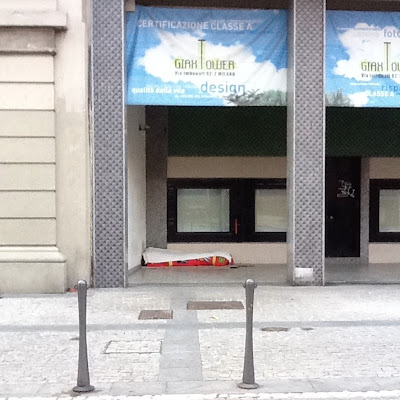 Some days ago I came upon an art gallery in Via Marsala, "Paraventi Giapponesi, Galleria Nobili". I suddenly stopped walking, to look at the window, because I saw little pieces of art that impressed me a lot. Even If the were just little compositions made of glass, they were so beautiful that I had to enter the art gallery and ask for some information.
Some days ago I came upon an art gallery in Via Marsala, "Paraventi Giapponesi, Galleria Nobili". I suddenly stopped walking, to look at the window, because I saw little pieces of art that impressed me a lot. Even If the were just little compositions made of glass, they were so beautiful that I had to enter the art gallery and ask for some information.
In this way, I discovered the work of Oki Izumi, a japanese lady working in Milan and producing glass sculptures (of different sizes) and jewels. She calls the jewels "sculptures to be worn" - smart and cool idea, perfectly suitable for the never-satisfied-with-the-simple-things Milan.
I also asked for the brochure and visited here elegant website, where you can also find some videos about her. In the brochure I had by the gallery manager, I found a description of Izumi's work that put me in the right conditions to introduce her here, in this personal subjective selection of art and creativity. I hope you'll be enthusiastic about her as I am.
(all the following images are taken from Oki Izumi website - go there to see even more!)
Oki Izumi is "special for glass" and her technique is very clear and precise (two fundamental qualities for a good piece of art). She works with glass sheets, of different thickness, and creates sculptures of any dimension. They could be big or small, but always appealing and somehow magnetic (not a banal quality for the glass!!).
They are magnetic in the way they reflect the light and create a sort of inviolable space, made of air, surrounding the pieces.
The glass so treated is no more only a material, but not even just an idea of transparency and pureness (as it was for the Western countries, when we started making building out of glass, looking for a sense of purity of the constructive field - see P. Behrens).
Matteo Galbiati wrote (Nov 2011) that her pieces aren't mere objects, but are pieces of art since she takes out, from the "cool" glass, a sort of vital energy. <The glass crystalize the invisible, and the artist has understood the power of this solidification of the immaterial>. It is the light that gives importance to this sculptures, without that the final effect would not be the same. No light, no magic.
The works that impressed me more were the small buildings made of glass, or just the ones recalling me an idea of construction or urban panoramas. I'll talk of this personal feeling, here.
This small creations made me think of the Deconstructionism and the current appreciation of "fluid architecture" as Zaha Hadid ones (just to give you an idea of what I'm talking of).
I think that this general madness for plastic and new materials (better appreciated if specially invented for one-time use) is evidently silly, compared with the simplicity of the glass. In this reasoning, the glass can be assumed as a "champion" of the traditional materials.
Why should we fill our house with melted tables or collapsed chairs, proportionally expensive to their decomposition level? It is always possible to create something new and interesting with sample shapes, if well used. Miss Izumi clearly represents this possibility. What's the use of blob furniture or buildings with identity crisis?
Don't tell me it's just the need of something new, because I'm intelligent enough not to be satisfied with this. No more!
In Izumi's art, the decomposition of the glass into sheets goes on with the re-composition of the pieces. I think it's like the principle of the Yin and of the Yang: there is no pleasure without the pain, there is no happiness without the sadness. In her work, I would say that the deconstructionism is fundamental as the recomposition is. She does not obtain her pieces without putting them again together, according to the inspiration and her sensibility. This is another quality of her work.
I think that a certain kind of architecture, nowadays so diffused also thanks to the 3D technology, definitely lack of something. It lacks a sense. It lacks the recomposition of the pieces. It's just like a Lego house, when you open the pack and take out the pieces. It's THEN that you have to put them together!
Fluid architecture and melted shapes are just the updated idea of the Deconstructionism to the current era. They can be interesting for some time, usually the time to see them on a magazine. But then, to me, nothing remain.
Fluid architecture and melted shapes are just the updated idea of the Deconstructionism to the current era. They can be interesting for some time, usually the time to see them on a magazine. But then, to me, nothing remain.


















































